As an Amazon Associate I earn from qualifying purchases.

I smoke a lot of salmon, and I am proud of this recipe, although it would be the height of arrogance to say that what I do is the end-all, be-all of salmon smoking recipes. Lots of people smoke their salmon in lots of ways, and many of them are good. But I’ve been smoking fish for many years, and I’ve developed a system that works well.
Keep in mind this is a hot-smoking recipe. Cold smoking, which is the kind of slice-able smoked fish you get in fancy boxes from Scotland is an entirely different thing.
Almost everyone in Salmon Country hot smokes their fish. If you’re unfamiliar with hot-smoked fish, think about those golden smoked whitefish you see in delicatessens; those are hot smoked.
How do you eat it? Well, you can just eat it plain, or you can flake it and make it into a smoked salmon salad, you can pound it with butter and make salmon rillettes, serve it in deviled eggs, tossed with pasta… you get the point.
Here’s what you need to get started:
- A smoker. I’ve uses a Traeger and a Bradley. Both are good. No matter what smoker you use, you will need to be able to a) know your smoking chamber’s temperature, and b) control the heat, at least in a rough sense.
- Wood. The only downside to a Traeger smoker is that you need to use their wood pellets. As a guy who used a Brinkmann wood-fired BBQ for years, fueling it with scraps of almond and other fruit woods, buying wood can be annoying, but you get better precision with this method. I prefer to use alder wood for my salmon, but apple, cherry, oak or maple work fine.
- Salt. Buy a box of kosher salt from the supermarket. Do not use regular table salt, as it contains iodide and anti-caking agents that will give your salmon an “off” flavor. I use Diamond Crystal, which is cut finer than Morton’s.
- Something sweet — salmon love sweet. I prefer to sweeten my smoked salmon with birch syrup; It’s just like maple syrup, only tapped from birch trees instead. Super cool stuff. But maple syrup is just as good. Just use real maple syrup, OK? Not the imitation crap. Honey works, too.
- A large plastic container. Buy the big, flat ones from the supermarket. They stack easily in a normal fridge, so you can have two different brines going. And they clean easily and are pretty cheap.
- A wire rack. You need to rest your brined fish on a rack with plenty of air circulation to form the all-important pellicle (more on that in a bit), and you will use it to rest the smoked fish before storing it.
- A basting brush. You probably already have this in your kitchen, but if not, pick one up. Get the flat kind, like you use to paint detail on window trim.
When you are ready to start, you will need smallish pieces of salmon about 1/4 to 1/2 pound each. Any salmonid fish will work with this recipe. I’ve done it with king salmon, sockeye, coho, and pink salmon, dolly varden, plus kokanee, steelhead and Lahontan trout.
There is no reason it would not work with chum salmon or any other char or trout species. And yes, it works with farmed Atlantic salmon, but I never eat the stuff.
I prefer to smoke salmon with its skin on, but I’ve done it with skinless pieces and it works fine.
Smoked Salmon
Ingredients
- 5 pounds salmon, trout or char
- Birch or maple syrup for basting
BRINE
- 1 quart cool water
- 1/3 cup Diamond Crystal kosher salt, about 2 ounces of any kosher salt
- 1 cup brown sugar
Instructions
- Mix together the brine ingredients and place your fish in a non-reactive container (plastic or glass), cover and put in the refrigerator. This curing process eliminates some of the moisture from the inside of the fish while at the same time infusing it with salt, which will help preserve the salmon.
- You will need to cure your salmon at least 4 hours, even for thin fillets from trout or pink salmon. In my experience, large trout or char, as well as pink, sockeye and silver salmon need 8 hours. A really thick piece of king salmon might need as much as 36 hours in the brine. Never go more than 48 hours, however, or your fish will be too salty. Double the brine if it's not enough to cover the fish.
- Take your fish out of the brine, rinse it briefly under cold running water, and pat it dry. Set the fillets on your cooling rack, skin side down. Ideally you'd do this right under a ceiling fan set on high, or outside in a cool, breezy place. By "cool" I mean 60°F or cooler. Let the fish dry for 2 to 4 hours (or up to overnight in the fridge). You want the surface of the fish to develop a shiny skin called a pellicle. This is one step many beginning smokers fail to do, but drying your cured, brined fish in a cool, breezy place is vital to properly smoking it. The pellicle, which is a thin, lacquer-like layer on top of the fish, seals it and offers a sticky surface for the smoke to adhere to. Don't worry, the salt in the brine will protect your fish from spoilage. Once you have your pellicle, you can refrigerate your fish for a few hours and smoke it later if you'd like.
- Start by slicking the skin of your fish with some oil, so it won't stick to the smoker rack. Know that even though this is hot smoking, you still do not want high temperatures. Start with a small fire and work your way up as you go. It is important to bring the temperature up gradually or you will get that white albumin "bleed" on the meat. I can control my heat with my smoker, so I start the process between 140°F and 150°F for up to an hour, then finish at 175°F for a final hour or two. NOTE: What my smoker is set at is not necessarily what the actual temperature is. Smoking is an art, not a science. To keep temperatures mild, always put water in your drip pan to keep the temperature down. If your smoker is very hot, like a Traeger can get, put ice in the tray.
- After an hour in the smoker, baste the fish with birch or maple syrup, or honey; do this every hour. This is a good way to brush away any albumin that might form. In most cases, you will get a little. You just don't want a ton of it. Even if you can't control your temperature this precisely, you get the general idea. You goal should be an internal temperature of about 130°F to 140°F. (Incidentally, yes, I keep the smoke on the whole time. I don't find this to be too much smoke, but if you want a lighter smoke, finish the salmon without smoke or in a 200°F oven.)
- You must be careful about your heat. Other than failing to dry your salmon long enough, the single biggest problem in smoking salmon is too high heat. If you've ever seen salmon "bleed" a white, creamy substance, that's a protein called albumin. If you see lots of it, you've screwed up; a little is normal. Here's what happens: If you cook a piece of salmon at too high a heat, the muscle fibers in the meat contract so violently that they extrude albumin, which immediately congeals on the surface of the fish. It's ugly, and it also means your salmon will be drier than it could have been. You prevent this with a solidly formed pellicle, and by keeping your heat gentle. If you let your heat get away from you and you do get a white mess on your salmon, all is not lost. Just flake it out and make salmon salad with it: The mayonnaise in the salad will mask any dryness.
- Once your fish is smoked, let it rest on the cooling rack for an hour before you put it in the fridge. Once refrigerated and wrapped in plastic, smoked fish will keep for 10 days. If you vacuum-seal it, the fish will keep for up to 3 weeks. Or freeze your fish for up to a year.
Notes
Nutrition
Nutrition information is automatically calculated, so should only be used as an approximation.
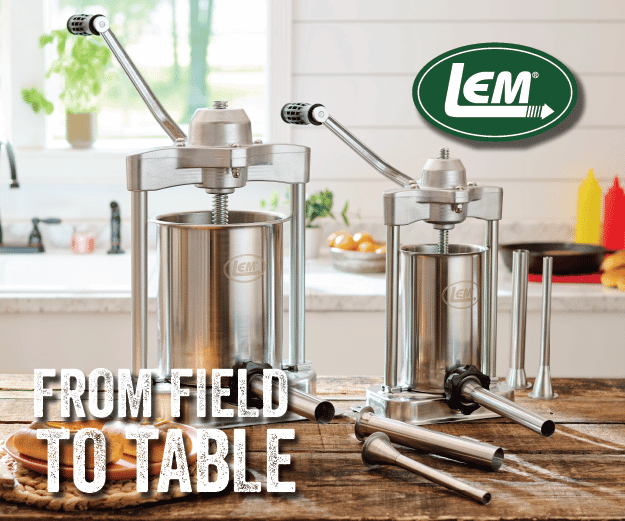
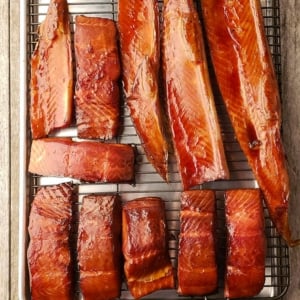
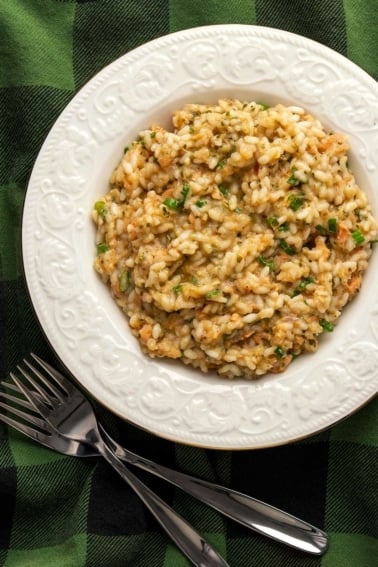
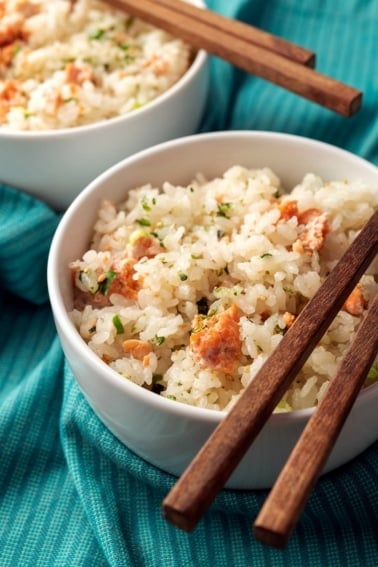
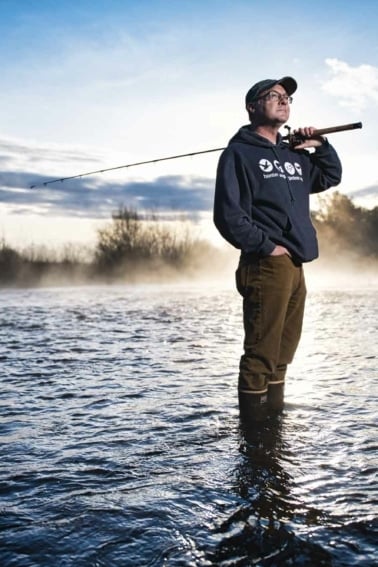
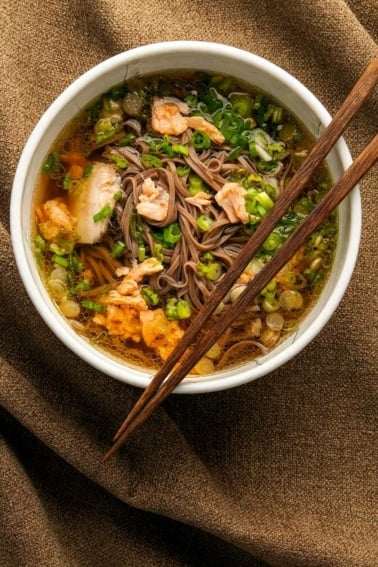
Absolute perfection! I brine in the morning. Before I go to bed I rinse it, pat it dry. stick it in the fridge and smoke it the next day. My brother forwarded this recipe to me after he made it one day. I got a smoker just because of this recipe it’s that good!
well i just got a wms smoker and was looking for a good recipe to smoke salmon, i don’t think i have to skill yet to control the temp that well but i certainly learned alot, thanks for the fine points. one thing i will try is starting in a cold pan when i pan fry salmon because i do get that white stuff most of the time and now i know why or at least i think i do. thank for the informative post
Thank you for the recipes. I usually invent my on but thought I would give your a try. I using your smoked salmon chowder recipe and it’s similar to the one I’ve used in the past with one exception, I usually add Sherry and tarragon which adds a slight different taste. I like the veggies sautéed in the bacon fat.
This is an excellent technique. Used Crystal Diamond kosher salt, light brown sugar in the brine, slightly-diluted maple syrup as a mop, brined 1#, inch thick cut of King salmon 24hrs, fridge-dried another 24hrs, smoked 2hrs to reach your rcmnded internal temp (Big Chief smoker running 165° throughout). Thought it might turn out too sweet, but it was not. Salt was spot on. Perfect in every way. Thank you, Hank Shaw!
While this recipe may be good to some, I found it to be much too salty tasting!
Not on my favourites list ?
I followed this recipe for prep and temperature and added my own spin on a maple syrup glaze. I smoked 2 rainbow trout and a large Atlantic salmon and it turned out amazing! Thank you for the comprehensive and much needed step by step guide. I never would have thought to air the salmon before smoking. I m on my way to checking out the rest of your recipes right now.?
I have used this recipe many times, thanks for sharing it
I have eaten a lot of salmon in my life. This is by far and away the best tasting recipe I have ever had. Don’t be afraid of the maple syrup if you have properly brined!
This is a awesome recipe!! My husband and I smoke and process all of are own meats. Always wanted to try smoking fish but we didn’t want to use our huge smoker for fish so we got out the little bullet smoker that started our madness of smoking meat ? and tried it old school, we used the honey glaze turnedout amazing!!! Thanks for sharing your perfect recipe ? ? ?
Love this simple recipe. So good with the maple syrup addition. I also tried and enjoyed a combination of maple syrup with some sriracha mixed in. Delicious.
I like your style. Friendly advice, not dogmatic, points out the things to avoid as well as the things to do.
Originally from Niagara county NY, I grew up on Salmon & Trout. I’ve smoked them both, I didn’t know the ins and outs you’ve noted. It makes a big difference in final product, Thank you for sharing, you process is spot on AAA+++. I like Maple, my Wife likes honey, Lol. Thx
Doug,
Can you add an additional amount of brown sugar on the fillets just prior to going into the smoker?
We did and it was yummy
Hi Hank. I have 2 lbs of wild caught salmon and wanted to know if the brine recipe is the same vs 5 ponds of salmon? Thanks 😉
Mike: The ratio will always be the same, and so long as you have enough brine to cover the fish, you’re fine.
I’ve used Hanks recipe for yrs now. I do a lot of smoking and this is the best recipe. All it takes is patience, i brine and dry one day and then smoke the next day. Soooo good.
First time smoker. Do you use the whole fillet or cut into pieces prior to smoking?
Thanks
Walt: I typically cut into large chunks, but if you are working with small fish, like pink salmon or little sockeyes, you can leave the fillets whole.
SO, SO helpful! I’ve done this recipe maybe 10 or so times now so far, and each time has turned out beautifully (unless I try it with cheap store bought salmon that was frozen, then it doesn’t seem to want to form the pellicle and it doesn’t turn out very good at all, but if I buy fresh wild caught salmon, it’s fantastic!) Anyway, I really appreciate you sharing this recipe! My entire family loves it!
Hi Hank,
I smoke salmon in a Luhr-Jensen Big Chief. My late Dad and I got started with a Little Chief 49 years ago–I was 11!
Dear Dad never measured for his brine so I’ve been going by-guess-and-by-gosh for years. Sometimes I had great success, other times I had disastrous failures. I’m glad to get a recipe like Dad’s at last. The capacity of my Chief is 50 pounds so I scaled the recipe accordingly. Thanks very much
One hour into the smoke going to spread some maple syrup now. Great website! I will comment and rate when finished.
Who has a 60 degree place to let the fish dry? I live in FL so it’s either 90, fridge, or 72 on the counter.
I was wondering the same, I’m in south Florida
Air drying uncovered in the fridge works just fine 🙂
We did this in the summer and live West Coast BC. Used 2 large fans with a bucket of ice in front to cool the air. Worked perfectly!
Alaska has 60 degree air . And lots of salmon too. I have spent my life living in Alaska raising our family . And fishing and hunting. we eat a lot of smoked fish . The recipes for smoking are wonderful .
This is a great recipe I’ve done many times. It got me hooked on smoked salmon and I’ve gone off in many different directions since. Curious, do you ever dry brine the salmon?
Doug: Yes, I’ll salt pieces down (dry brine) when I only have a few. The brine is better when you are smoking a lot of salmon.
Do you use just salt, or add brown sugar? How long does dry brining typically take for a 1.5 lb filet?
Doug: Yes, I use both. The general rule is 1 hour in the packed salt for every pound the piece is, so in your case about 90 minutes. Rinse, then dry, then smoke.